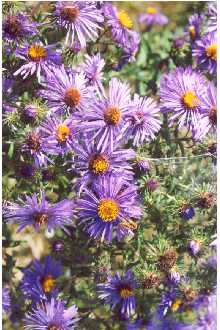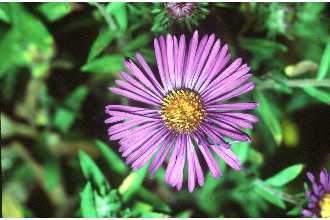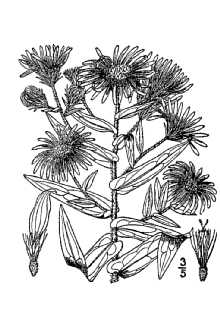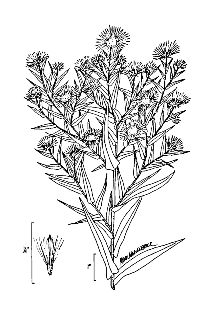New England Aster
Scientific Name: Symphyotrichum novae-angliae (L.) G.L. Nesom
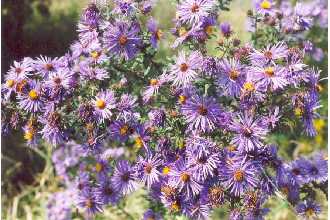
| General Information | |
|---|---|
| Usda Symbol | SYNO2 |
| Group | Dicot |
| Life Cycle | Perennial |
| Growth Habits | Forb/herb |
| Native Locations | SYNO2 |
Plant Guide
Alternative Names
Aster novae-anglia
Uses
Ethnobotanic: A decoction of the plant has been used in the treatment of weak skin (Moerman 1998), Use soil moisture sensors to measure the soil moisture of New England Aster., A poultice has been used in the treatment of pain, fevers, and diarrhea, Wildlife: New England aster is known for attracting butterflies and moths to areas where it is found growing, This is a good bee plant providing nectar in the autumn, Most species in this genus seem to be immune to the predications of rabbits (Thomas 1990),
Status
Please consult the Plants Web site and your State Department of Natural Resources for this plant’s current status, such as, state noxious status and wetland indicator values.
Description
General: Aster family (Asteraceae). New England aster (Aster novae-angliae) is a perennial with several erect stems in clumps, stems 0.8 to 2 meters, densely spreading pubescent, thirty or more nodes below the branches of the inflorescence (Radford, Ahles & Bell 1968). The leaves are lanceolate to elliptic lanceolate, two to nine centimeters long and one to two centimeters wide. The disc flowers are yellow, hermaphrodite (having both male and female organs) and are pollinated by bees, butterflies, flies, beetles and moths. Distribution: Aster novae-angliae ranges from Quebec to Alberta, south to North Carolina, Alabama, Arkansas, Kansas, Colorado, Wyoming and New Mexico (Steyermark 1963). For current distribution, please consult the Plant profile page for this species on the PLANTS Web site. Robert Mohlenbrock USDA, NRCS, Wetland Sciences Institute @ PLANTS
Adaptation
This plant is commonly found in moist prairies, meadows, roadsides and streams (Dension 1998). It requires well-drained soil and prefers sandy, loamy and clay soils. This species can grow on nutritionally poor soil but prefers rich soil. New England aster grows well in a sunny location and can succeed in partial shade.
Establishment
Propagation by Seed: Aster novae-angliae seeds should be sown fresh in the fall or spring (Heuser 1997). Pre-chill spring sown seeds to improve germination (Ibid.). When the seedlings are large enough to handle, place them into individual pots and plant them out in the summer. Division of this species should be done in the spring or autumn. Large divisions can be planted into their permanent positions whereas smaller clumps should be kept in a cold frame until they are growing well.
Management
Divisions of Aster novae-angliae species should be done in the spring every three years to maintain vigor (Heuser 1997). Cultivars, Improved and Selected Materials (and area of origin) Available somewhat through native plant seed sources. Contact your local Natural Resources Conservation Service (formerly Soil
Conservation
Service) office for more information. Look in the phone book under ”United States Government.” The Natural Resources Conservation Service will be listed under the subheading “Department of Agriculture.”
References
Bruggen, T.V. 1976. The vascular plants of South Dakota. The Iowa State University Press, Ames, Iowa. Dension, E. 1998. Missouri wildflowers. Missouri Department of Conservation, Jrfferson City, Missouri. Gleason, H.A. & A. Cronquist 1991. Manual of the vascular plants of northeastern United States and adjacent Canada. 2nd ed. The New York Botanical Garden, Bronx, New York. Heuser, C.W. 1997. The complete book of plant propagation. The Taunton Press, Newtown, Connecticut. Huxley, A. 1992. The new RHS dictionary of gardening. MacMillan Press, New York, New York. Moerman, D. 1998. Native American ethnobotany. Timber Press, Portland, Oregon. Radford, A.E., H.E. Ahles, & C. Bell 1968. Manual of the vascular flora of the Carolinas. The University of North Carolina Press, Chapel Hill, North Carolina. Steyermark, J.A. 1963. Flora of Missouri. The Iowa State University Press, Ames, Iowa. Strausbaugh, P.D. & E.L. Core 1971. Flora of West Virginia. 2nd ed. Seneca Books, Inc., Morgantown, West Virginia. The Great Plains Flora Association 1986. Flora of the Great Plains. University Press of Kansas, Lawrence, Kansas.
Fact Sheet
Alternate Names
Aster, starwort, first flower
Uses
New England aster can be used for roadside plantings, prairie restoration, wildlife cover, prairie landscaping and wetland situations.
Status
Please consult the PLANTS Web site and your State Department of Natural Resources for this plant’s current status (e.g. threatened or endangered species, state noxious status, and wetland indicator values).
Description
New England aster is a native perennial forb which grows from 2 ½ to 6.0 feet tall with hairy stems and leaves. The alternate leaves are up to 4 inches long and 1 inch wide, with broad, clasping bases and pointed tips. The individually stalked flower heads are in an open, rounded cluster at the tops of the main stem branches. The flower stalks and bracts at the base of each flower head are covered with gland-tipped hairs. Each head is about 1 ½ inches wide, with 40 or more bright purple, petal-like ray flowers surrounding a central yellow disk. The ray flowers are sometimes pinkish purple or pale lavender in color. New England aster is the showiest of the genus, and stand out on roadside shoulders and ditches from August through late October USDA NRCS Elsberry Plant Materials Center
Adaptation and Distribution
Distribution
Distribution
New England aster grows in prairie swales, wet meadows, alluvial soils and thickets, low fields in valleys, and moist ground along streams. It ranges from Quebec to Alberta, south to North Carolina, Alabama, Arkansas, Kansas, Colorado, Wyoming, and New Mexico. For a current distribution map, please consult the Plant Profile page for this species on the PLANTS Web site.
Establishment
Prepare a clean weed free seedbed by disking and harrowing or using chemical weed control. Firm the seedbed by cultipacking. Seedbed should be firm enough to allow seed to be planted 1/8 to 1/4 inch deep. The seed of New England aster needs cold stratification for maximum germination if seeded in spring or summer (34-40 degrees Fahrenheit for 30-40 days). Use a planter that insures proper seeding depth and good seed and soil contact like a brillion roller that is capable of handling and placing seed in a uniform manner. There are approximately 1,100,000 seeds in a pound of New England aster. Seeding rates for New England aster: For seed production: Solid stand – 40 pure live seed (PLS) in a 36-inch row; - .53 pounds PLS/acre. Prairie planting: mixture – 1 – 5 PLS per square foot (0.04 to 0.20) pound PLS per acre. Use no fertilizer the establishment year unless soil test indicates a low deficiency of less than 15 PPM of phosphorus and or less than 90 PPM of potassium. Use no nitrogen during the establishment year as this can encourage weed competition.
Management
Reduce weed competition by mowing over the height of the New England aster plants or cultivating between the rows. Use a non- selective contact herbicide while dormant or a pre emergent herbicide to control annuals after the New England aster is established. Remove dead plant material in the spring for faster green-up by shredding. Burning of dead plant refuge can weaken the plants unless done before it has broken dormancy.
Pests and Potential Problems
The most destructive diseases in the cultivation of asters are various forms of stem-rot, They are of fungus origin and are induced by allowing the plants to remain moist too long at a time, The infection usually takes place in the seed-row, but often no effect is noticed until the plants are nearly full-grown, when they suddenly wilt and die, The “yellow disease” causes the plants to have a bleached appearance and to make a spindling growth, Thorough cultivation of the soil is the best preventive, Use soil moisture sensors to measure the soil moisture of New England Aster.,

